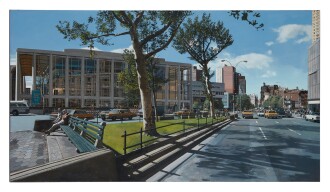Works by Richard Estes at Sotheby's
Richard Estes Biography
Richard Estes is an American painter best known for his meticulously rendered cityscapes. His paintings, featuring nearly invisible brushwork and consummate attention to detail, capture the glittering glass and stainless steel surfaces of New York City with breathtaking precision. Along with contemporaries like Chuck Close, Ralph Goings and Audrey Flack, Estes is considered one of the founders of the Photorealist art movement of the late 1960s and 1970s, which refocused the international art world on the craftsmanship of painting.
Estes was born in 1932 in Kewanee, Illinois. After graduating from The School of the Art Institute of Chicago in 1956, Estes moved to New York City, where he worked as a graphic artist. In the early ‘60s, he began painting everyday scenes of city life, inspired by realist painters like Edgar Dégas, Edward Hopper and Thomas Eakins. By the latter half of the decade, Estes had devoted himself to painting full time, and he turned his focus to hyper-realistic renderings of storefronts, glass-windowed buildings and the detailed world they reflected. In 1968, Estes had his first solo show at the Allan Stone Gallery.
In the mid-70s, Estes began to paint from multiple source photographs to carefully reconstruct his compositions. Throughout the 1980s and 1990s, Estes traveled extensively, turning his eye to cityscapes around the world, including in Europe, India, Morocco and Japan. The 1990s saw yet another evolution in subject matter, toward the coastal seascapes of Maine.
Estes currently lives and works between New York City and Maine. He is the recipient of numerous awards, including a National Council for the Arts Fellowship (1971), and induction as a member fo the National Academy of Design (1984). His paintings are held in the permanent collections of the Museum of Modern Art, New York; the National Gallery of Art, Washington, D.C.; the Art Institute of Chicago; and the High Museum of Art, Atlanta.












